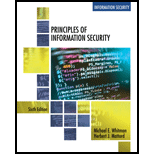
Annualized Rate Occurrence (ARO):
Annualized Rate Occurrence is the estimated frequency at which a given threat is expected to happen.
ARO can be calculated by using the following formula:
Annualized Loss Expectancy (ALE):
Annualized loss expectancy is the loss expected from the attack of a specific information asset which has been carried over for a year. It is a product of single loss expectancy and the annualized rate of occurrence.
ALE can be calculated by using the following formula:
Explanation of Solution
Calculate ARO for Programmer mistakes:
Substitute the value of “One year” as “365” and “Frequency of occurrence (One per week)” as “7” in the equation (1).
Hence, the ARO for programmer mistakes is “52 (approximately)”.
Calculate ARO for Loss if intellectual property:
Substitute the value of “One year” as “365” and “Frequency of occurrence (One per year)” as “365” in the equation (1).
Hence, the ARO for Loss if intellectual property is “1 (approximately)”.
Calculate ARO for Software Piracy:
Substitute the value of “One year” as “365” and “Frequency of occurrence (One per week)” as “7” in the equation (1).
Hence, the ARO for Software Piracy is “52 (approximately)”.
Calculate ARO for Theft of information (hacker):
Substitute the value of “One year” as “365” and “Frequency of occurrence (One per quarter)” as “
Hence, the ARO for Theft of information (hacker) is “4 (approximately)”.
Calculate ARO for Theft of information (employee):
Substitute the value of “One year” as “365” and “Frequency of occurrence (One per 6 months)” as “
Hence, the ARO for Theft of Theft of information (employee) is “2 (approximately)”.
Calculate ARO for Web defacement:
Substitute the value of “One year” as “365” and “Frequency of occurrence (One per months)” as “
Hence, the ARO for Web defacement is “12 (approximately)”.
Calculate ARO for Theft of equipment:
Substitute the value of “One year” as “365” and “Frequency of occurrence (One per year)” as “365” in the equation (1).
Hence, the ARO for Theft of equipment is “1 (approximately)”.
Calculate ARO for Viruses, worms, Trojan Horses:
Substitute the value of “One year” as “365” and “Frequency of occurrence (One per week)” as “7” in the equation (1).
Hence, the ARO for Viruses, worms, Trojan Horses is “52 (approximately)”.
Calculate ARO for Denial-of-service attacks:
Substitute the value of “One year” as “365” and “Frequency of occurrence (One per quarter)” as “
Hence, the ARO for Denial-of-service attacks is “4 (approximately)”.
Calculate ARO for Earthquake:
Substitute the value of “One year” as “365” and “Frequency of occurrence (One per 20 years)” as “
Hence, the ARO for Earthquake is “0.05 (approximately)”.
Calculate ARO for Food:
Substitute the value of “One year” as “365” and “Frequency of occurrence (One per 10 years)” as “
Hence, the ARO for Food is “0.1 (approximately)”.
Calculate ARO for Fire:
Substitute the value of “One year” as “365” and “Frequency of occurrence (One per 10 years)” as “
Hence, the ARO for Fire is “0.1 (approximately)”.
Calculate ALE for Programmer mistakes:
Substitute the value of “SLE” as “5000” and “ARO” as “52” in the equation (2).
Hence, the ALE for programmer mistakes is “260000”.
Calculate ALE for Loss if intellectual property:
Substitute the value of “SLE” as “75000” and “ARO” as “1” in the equation (2).
Hence, the ALE for Loss if intellectual property is “75000”.
Calculate ALE for Software Piracy:
Substitute the value of “SLE” as “500” and “ARO” as “52” in the equation (2).
Hence, the ALE for Software Piracy is “26000”.
Calculate ALE for Theft of information(hacker):
Substitute the value of “SLE” as “2500” and “ARO” as “4” in the equation (2).
Hence, the ALE for Theft of information (hacker)is “10000”.
Calculate ALE for Theft of information (employee)
Substitute the value of “SLE” as “5000” and “ARO” as “2” in the equation (2).
Hence, the ALE for Theft of information (employee) is “10000”.
Calculate ALE for Web defacement:
Substitute the value of “SLE” as “500” and “ARO” as “12” in the equation (2).
Hence, the ALE for Web defacement is “6000”.
Calculate ALE for Theft of equipment:
Substitute the value of “SLE” as “5000” and “ARO” as “1” in the equation (2).
Hence, the ALE for Theft of equipment is “6000”.
Calculate ALE for Viruses, worms, Trojan Horses:
Substitute the value of “SLE” as “1500” and “ARO” as “52” in the equation (2).
Hence, the ALE for Viruses, worms, Trojan Horses is “78000”.
Calculate ALE for Denial-of-service attacks:
Substitute the value of “SLE” as “2500” and “ARO” as “4” in the equation (2).
Hence, the ALE for Denial-of-service attacks is “10000”.
Calculate ALE for Earthquake:
Substitute the value of “SLE” as “250000” and “ARO” as “0.05” in the equation (2).
Hence, the ALE for Earthquake is “12500”.
Calculate ALE for Food:
Substitute the value of “SLE” as “250000” and “ARO” as “0.1” in the equation (2).
Hence, the ALE for Food is “25000”.
Calculate ALE for Fire:
Substitute the value of “SLE” as “500000” and “ARO” as “0.1” in the equation (2).
Hence, the ALE for Fire is “50000”.
ARO and ALE table for all the threat cost is given below:
| ARO and ALE threat cost | ARO | ALE |
| Programmer mistakes | 52 | $260,000 |
| Loss if intellectual property | 1 | $75,000 |
| Software Piracy | 52 | $26,000 |
| Theft of information(hacker) | 4 | $10,000 |
| Theft of information (employee) | 2 | $10,000 |
| Web defacement | 12 | $6,000 |
| Theft of equipment | 1 | $5,000 |
| Viruses, worms, Trojan Horses | 52 | $78,000 |
| Denial-of-service attacks | 4 | $10,000 |
| Earthquake | 0.05 | $12,500 |
| Food | 0.1 | $25,000 |
| Fire | 0.1 | $50,000 |
Want to see more full solutions like this?
Chapter 5 Solutions
Principles Of Information Security, Loose-leaf Version
- The following relations keep track of airline flight information: Flights(flno: integer, from: string, to: string, distance: integer, departs: time, arrives: time, price: integer) Aircraft(aid: integer, aname: string, cruisingrange: integer) Certified(eid: integer, aid: integer) Employees(eid: integer, ename: string, salary: integer) Note that the Employees relation describes pilots and other kinds of employees as well; every pilot is certified for some aircraft, and only pilots are certified to fly. Write each of the following queries in SQL.(Additional queries using the same schema are listed in the exercises for Chapter 4) a. Identify the routes that can be piloted by every pilot who makes more than $100,000. b. Print the name and salary of every nonpilot whose salary is more than the average salary for pilots. c. Print the names of employees who are certified only on aircrafts with cruising range longer than 1000 miles and who are certified on some Boeing…arrow_forwardNeed help making python code for this!arrow_forward2.7 LAB: Smallest of two numbers Instructor note: Note: this section of your textbook contains activities that you will complete for points. To ensure your work is scored, please access this page from the assignment link provided in the CTU Virtual Campus. If you did not access this page via the CTU Virtual Campus, please do so now.arrow_forward
- I help understanding this question d'y + 4dy +3y = a, Initial Conditions: y(0) = 5 & y'(0)=0 Where a = 10 a) Find y(t) =yh(t) +yp(t) in time domainIs the system over-damped, under-damped, or critical? b) Find y(t) using Laplace Transformsarrow_forwardGiven f(t)=a sin(ßt) a = 10 & ß = 23 Find the Laplace Transform using the definition F(s) = ∫f(t)e-stdtarrow_forwardPlease do not use any AI tools to solve this question. I need a fully manual, step-by-step solution with clear explanations, as if it were done by a human tutor. No AI-generated responses, please.arrow_forward
- Obtain the MUX design for the function F(X,Y,Z) = (0,3,4,7) using an off-the-shelf MUX with an active low strobe input (E).arrow_forwardI cannot program smart home automation rules from my device using a computer or phone, and I would like to know how to properly connect devices such as switches and sensors together ? Cisco Packet Tracer 1. Smart Home Automation:o Connect a temperature sensor and a fan to a home gateway.o Configure the home gateway so that the fan is activated when the temperature exceedsa set threshold (e.g., 30°C).2. WiFi Network Configuration:o Set up a wireless LAN with a unique SSID.o Enable WPA2 encryption to secure the WiFi network.o Implement MAC address filtering to allow only specific clients to connect.3. WLC Configuration:o Deploy at least two wireless access points connected to a Wireless LAN Controller(WLC).o Configure the WLC to manage the APs, broadcast the configured SSID, and applyconsistent security settings across all APs.arrow_forwardusing r language for integration theta = integral 0 to infinity (x^4)*e^(-x^2)/2 dx (1) use the density function of standard normal distribution N(0,1) f(x) = 1/sqrt(2pi) * e^(-x^2)/2 -infinity <x<infinity as importance function and obtain an estimate theta 1 for theta set m=100 for the estimate whatt is the estimate theta 1? (2)use the density function of gamma (r=5 λ=1/2)distribution f(x)=λ^r/Γ(r) x^(r-1)e^(-λx) x>=0 as importance function and obtain an estimate theta 2 for theta set m=1000 fir the estimate what is the estimate theta2? (3) use simulation (repeat 1000 times) to estimate the variance of the estimates theta1 and theta 2 which one has smaller variance?arrow_forward
- using r language A continuous random variable X has density function f(x)=1/56(3x^2+4x^3+5x^4).0<=x<=2 (1) secify the density g of the random variable Y you find for the acceptance rejection method. (2) what is the value of c you choose to use for the acceptance rejection method (3) use the acceptance rejection method to generate a random sample of size 1000 from the distribution of X .graph the density histogram of the sample and compare it with the density function f(x)arrow_forwardusing r language a continuous random variable X has density function f(x)=1/4x^3e^-(pi/2)^4,x>=0 derive the probability inverse transformation F^(-1)x where F(x) is the cdf of the random variable Xarrow_forwardusing r language in an accelerated failure test, components are operated under extreme conditions so that a substantial number will fail in a rather short time. in such a test involving two types of microships 600 chips manufactured by an existing process were tested and 125 of them failed then 800 chips manufactured by a new process were tested and 130 of them failed what is the 90%confidence interval for the difference between the proportions of failure for chips manufactured by two processes? using r languagearrow_forward
 Management Of Information SecurityComputer ScienceISBN:9781337405713Author:WHITMAN, Michael.Publisher:Cengage Learning,
Management Of Information SecurityComputer ScienceISBN:9781337405713Author:WHITMAN, Michael.Publisher:Cengage Learning, Principles of Information Systems (MindTap Course...Computer ScienceISBN:9781285867168Author:Ralph Stair, George ReynoldsPublisher:Cengage Learning
Principles of Information Systems (MindTap Course...Computer ScienceISBN:9781285867168Author:Ralph Stair, George ReynoldsPublisher:Cengage Learning Information Technology Project ManagementComputer ScienceISBN:9781337101356Author:Kathy SchwalbePublisher:Cengage Learning
Information Technology Project ManagementComputer ScienceISBN:9781337101356Author:Kathy SchwalbePublisher:Cengage Learning Information Technology Project ManagementComputer ScienceISBN:9781285452340Author:Kathy SchwalbePublisher:Cengage Learning
Information Technology Project ManagementComputer ScienceISBN:9781285452340Author:Kathy SchwalbePublisher:Cengage Learning Principles of Information Systems (MindTap Course...Computer ScienceISBN:9781305971776Author:Ralph Stair, George ReynoldsPublisher:Cengage LearningCOMPREHENSIVE MICROSOFT OFFICE 365 EXCEComputer ScienceISBN:9780357392676Author:FREUND, StevenPublisher:CENGAGE L
Principles of Information Systems (MindTap Course...Computer ScienceISBN:9781305971776Author:Ralph Stair, George ReynoldsPublisher:Cengage LearningCOMPREHENSIVE MICROSOFT OFFICE 365 EXCEComputer ScienceISBN:9780357392676Author:FREUND, StevenPublisher:CENGAGE L





